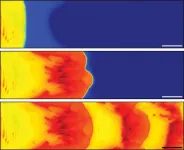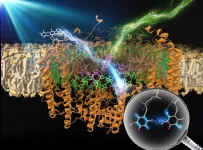Creating patterns spontaneously in synthetic materials
2021-03-24
(Press-News.org) Nature produces a startling array of patterned materials, from the sensitive ridges on a person's fingertip to a cheetah's camouflaging spots. Although nature's patterns arise spontaneously during development, creating patterns on synthetic materials is more laborious. Now, researchers reporting in ACS Central Science have found an easy way to make patterned materials having complex microstructures with variations in mechanical, thermal and optical properties -- without the need for masks, molds or printers.
In animals, patterns form before birth in response to genetically controlled signals that often vary in concentration along a gradient. In contrast, traditional manufacturing approaches for creating patterns and structures involve multiple steps, such as layer-by-layer assembly, lithography, molding or casting. Jeffrey Moore, Nancy Sottos, Philippe Geubelle and colleagues wanted to develop a spontaneous patterning method more akin to the biological process.
The team placed a solution of dicyclopentadiene monomer in a channel and then heated one end of the channel. The heat activated a ruthenium catalyst, which caused the monomer to polymerize, generating more heat that traveled down the channel. This continued to happen until all available monomer in the region was consumed. Eventually, heat traveled farther down the channel to a location where fresh monomer was present, and the process began again. With this technique, the team produced resins with regular ridges, and they controlled the height and spacing of the ridges by adjusting the initial temperature of the solution. By using a different monomer or adding other compounds to the solution, the researchers created materials with patterns of color and stiffness. The new method could someday be used to create a variety of new "smart" materials, from tire or shoe treads to electronics and biomaterials, the researchers say.
INFORMATION:
The authors acknowledge funding from the END
[Attachments] See images for this press release:

ELSE PRESS RELEASES FROM THIS DATE:
2021-03-24
Honeybees play a scent-driven game of telephone to guide members of a colony back to their queen, according to a new study led by University of Colorado Boulder. The research, published today in the Proceedings of the National Academy of Sciences, highlights how insects with limited cognitive abilities can achieve complex feats when they work together--even creating what looks like a miniature and buzzing version of a telecommunications network.
The findings also serve as a testament to a honeybee's love for its queen. These matriarchs are the most important members of any hive: They're the only females able ...
2021-03-24
Given the finite nature of fossil fuel reserves and the devastating environmental impacts of relying on fossil fuels, the development of clean energy sources is among the most pressing challenges facing modern industrial civilization. Solar energy is an attractive clean energy option, but the widescale implementation of solar energy technologies will depend on the development of efficient ways of converting light energy into chemical energy.
Like many other research groups, the members of Professor Takehisa Dewa's research team at Nagoya Institute of Technology in Japan have turned to biological photosynthetic apparatuses, which ...
2021-03-24
[Background]
Decreasing the emission and efficient utilization (fixation) of carbon dioxide (CO2) are worldwide issues to prevent global warming. Promotion of the use of renewable energy is effective in reducing CO2 emissions. However, since there are large time-dependent fluctuations and large regional differences in renewable energy production, it is necessary to establish a fixation technology to allow efficient energy transportation and storage. Thus, there is increasing interest in technologies for synthesizing useful chemicals from CO2 using electricity derived from renewable energy. ...
2021-03-24
A new study suggests that Sargramostim, a medication often used to boost white blood cells after cancer treatments, is also effective in treating and improving memory in people with mild-to-moderate Alzheimer's disease. This medication comprises of a natural human protein produced by recombinant DNA technology (yeast-derived rhu GM-CSF/Leukine®).
The study, from the University of Colorado Alzheimer's and Cognition Center at the University of Colorado Anschutz Medical Campus (CU Anschutz), presents evidence from their clinical trial that shows that Sargramostim may ...
2021-03-24
(Boston)--Being persistently lonely during midlife (ages 45-64) appears to make people more likely to develop dementia and Alzheimer's Disease (AD) later in life. However, people who recover from loneliness, appear to be less likely to suffer from dementia, compared to people who have never felt lonely.
Loneliness is a subjective feeling resulting from a perceived discrepancy between desired and actual social relationships. Although loneliness does not itself have the status of a clinical disease, it is associated with a range of negative health outcomes, including sleep disturbances, depressive symptoms, cognitive impairment, and stroke. Still, feeling lonely may happen to anyone at some point in life, ...
2021-03-24
A new study shows that if the population were fixed at current levels, the risk of population displacement due to river floods would rise by ~50% for each degree of global warming. However, if population increases are taken into account, the relative global flood displacement risk is significantly higher.
The research, by an international team from Switzerland, Germany, and the Netherlands, used a global climate-, hydrology- and inundation-modelling chain, including multiple alternative climate and hydrological models, to quantify the effect of global warming on displacement ...
2021-03-24
Extremely hot and dry conditions that currently put parts of the UK in the most severe danger of wildfires once a century could happen every other year in a few decades' time due to climate change, new research has revealed.
A study, led by the University of Reading, predicting how the danger of wildfires will increase in future showed that parts of eastern and southern England may be at the very highest danger level on nearly four days per year on average by 2080 with high emissions, compared to once every 50-100 years currently.
Wildfires need a source of ignition which ...
2021-03-24
Deforestation, certain types of reforestation and commercial palm plantations correlate with increasing outbreaks of infectious disease, shows a new study in Frontiers in Veterinary Science. This study offers a first global look at how changes in forest cover potentially contribute to vector-borne diseases--such as those carried by mosquitos and ticks--as well as zoonotic diseases, like Covid-19, which jumped from an animal species into humans. The expansion of palm oil plantations in particular corresponded to significant rises in vector-borne ...
2021-03-24
Research shows that children prefer to befriend, listen to, and imitate people who speak similarly to them. While most of this research has been conducted on monolingual (speaking only one language) children from Western societies, a growing subset of research has begun examining whether this pattern holds for children from more diverse linguistic and cultural backgrounds. A new meta-analysis including studies with monolingual as well as bilingual children helps to shed light on the range of factors that contribute to the development of linguistic-based biases in early childhood. Understanding these patterns can eventually guide efforts to diminish biases based on how one speaks.
The findings were published in a Child Development article written by researchers ...
2021-03-24
Throughout the world, societies discriminate against and mistreat members of certain social groups. Young children may express intergroup biases that lead to such outcomes, demonstrating preferences for their own over other groups. How these biases develop is an important topic of study in today's climate. A new longitudinal study mimicked a situation in which children might overhear derogatory messages about a new social group. The study revealed that overhearing a stranger's negative claims about a social group, even in a brief comment, can have a lasting influence on children's attitudes towards the group.
The findings were published in a Child ...
LAST 30 PRESS RELEASES:
[Press-News.org] Creating patterns spontaneously in synthetic materials



